Introduction: A Revolution in Seeing
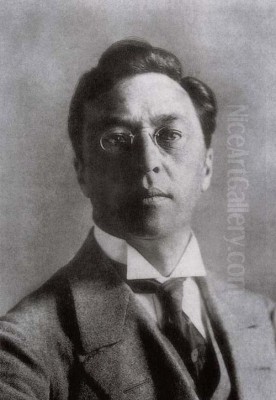
Wassily Kandinsky stands as a towering figure in twentieth-century art, celebrated primarily as a pioneer of abstract painting. Born in Russia, his life and work traversed the tumultuous landscapes of imperial Moscow, avant-garde Munich, revolutionary Russia, the experimental Bauhaus in Germany, and finally, artistic Paris. More than just a painter, Kandinsky was a profound theorist, educator, and spiritual seeker whose ideas about the inner life of art fundamentally reshaped modern visual culture. He sought to liberate painting from the constraints of representing the external world, aiming instead to give form to the unseen realms of emotion, spirit, and cosmic harmony, often drawing parallels between painting and music. His journey from a promising career in law to becoming a founding father of abstraction is a compelling story of artistic conviction and relentless innovation.
Early Life and the Call to Art
Wassily Wassilyevich Kandinsky was born in Moscow on December 16, 1866 (December 4, Old Style), into a comfortable, cultured family. His father was a tea merchant, and his mother was a musician, instilling in him an early appreciation for both the visual and auditory arts. His childhood was spent partly in Odessa after his parents separated, where he learned to play the piano and cello and took drawing lessons. These early experiences with music and color deeply marked him, laying the groundwork for his later theories on the interconnectedness of the senses, particularly synesthesia – the phenomenon of experiencing one sense through another, like hearing colors or seeing sounds.
Despite his artistic inclinations, Kandinsky initially pursued a more conventional path. He enrolled at the University of Moscow in 1886, studying law and economics. He proved to be a successful student, eventually earning a doctorate and securing a position as a teaching associate at the university's Faculty of Law. In 1892, he married his cousin, Anna Chimiankina. His academic career seemed set, and he was even offered a professorship at the University of Dorpat (now Tartu, Estonia). However, two profound experiences around the age of 30 irrevocably altered his course.
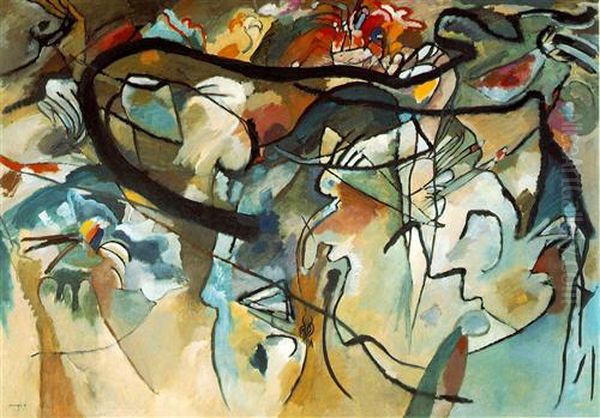
The first was encountering an exhibition of French Impressionists in Moscow in 1896, particularly Claude Monet's Haystacks series. Kandinsky was struck by the painting's power, which seemed to emanate purely from color and form, almost independent of the subject matter itself. He later recalled realizing that the object in painting could be secondary, even unnecessary. The second pivotal moment was attending a performance of Richard Wagner's opera Lohengrin at the Bolshoi Theatre. The music evoked powerful visual imagery in his mind – "wild, almost crazy lines," vibrant colors – confirming his burgeoning belief in the profound link between sound and sight, and the potential for painting to achieve the abstract, emotional power of music.
Munich: The Crucible of Abstraction
In 1896, at the age of 30, Kandinsky made the life-altering decision to abandon his legal career and dedicate himself entirely to art. He moved to Munich, then a major European art center buzzing with Symbolist and Jugendstil (Art Nouveau) energies. He sought formal training, first enrolling in the private art school of Anton Ažbe, where he honed his drawing skills, and later, after initially being rejected, gaining admission to the prestigious Munich Academy of Arts in 1900. There, he studied under Franz von Stuck, a prominent Symbolist painter known for his precise draftsmanship, though Kandinsky found the academic focus on traditional techniques somewhat stifling.
During his Munich years, Kandinsky absorbed various influences, moving through phases inspired by Impressionism, Pointillism, and Fauvism. His early works often depicted Russian folk scenes, fairy tales, and landscapes, rendered in jewel-like colors and flattened perspectives, reflecting an interest sparked by an ethnographic trip to the Vologda region of Russia in 1889, where he was captivated by the vibrant decorations of peasant homes and churches. He co-founded the Phalanx group in 1901, organizing exhibitions to showcase avant-garde art, including works by Monet. It was at the Phalanx school that he met Gabriele Münter, a talented young artist who became his student, companion, and artistic collaborator for over a decade.
Together with Münter, Kandinsky traveled extensively between 1904 and 1908, spending time in Italy, the Netherlands, North Africa, and France. Paris exposed him further to the radical color experiments of the Fauves, like Henri Matisse and André Derain, and the structural innovations of Paul Cézanne. Returning to Bavaria, he, Münter, Alexej von Jawlensky, and Marianne von Werefkin spent summers painting in the village of Murnau from 1908. Here, inspired by the intense light, dramatic landscapes, and local folk traditions (especially Bavarian glass painting), Kandinsky's style underwent a dramatic transformation. His colors became bolder, less descriptive, and more emotionally charged; forms simplified, and the push towards abstraction intensified. Works like The Blue Rider (1903) hinted at his future direction, while paintings from the Murnau period show a rapid dissolution of representational imagery.
Der Blaue Reiter and the Breakthrough
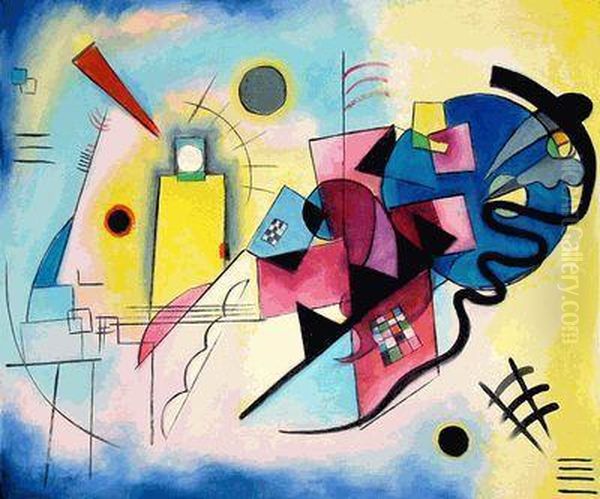
The years leading up to World War I were a period of extraordinary creative ferment for Kandinsky. In 1909, he co-founded the Neue Künstlervereinigung München (NKVM, New Artists' Association of Munich). However, disagreements over the direction of art, particularly Kandinsky's increasingly abstract tendencies, led him and Franz Marc to break away in 1911. They swiftly organized a counter-exhibition under the name Der Blaue Reiter (The Blue Rider), a name derived from Kandinsky's 1903 painting and reflecting both artists' love for the color blue and the spiritual symbolism of the horse and rider.
Der Blaue Reiter was not a formal movement with a strict manifesto but rather a loose association of artists united by a shared interest in spiritual expression, symbolism, primitivism, folk art, children's art, and the expressive potential of color and form. Key figures associated with the group included August Macke, Paul Klee, Alexej von Jawlensky, Marianne von Werefkin, Lyonel Feininger, and the composer Arnold Schoenberg, whose atonal music Kandinsky deeply admired and saw as analogous to his own abstract painting. The group organized two influential exhibitions (1911 and 1912) and published the highly significant Blue Rider Almanac (1912), a collection of essays and images exploring diverse artistic expressions from different cultures and periods, championing the idea of an underlying spiritual unity in all true art.
During this period, Kandinsky achieved his definitive breakthrough into pure abstraction. Around 1910-1913, he created works widely considered among the first completely non-representational paintings in modern Western art, including the famous (though possibly later dated) First Abstract Watercolor (c. 1910 or 1913). He began categorizing his works into three types: Impressions (inspired by direct observation of nature), Improvisations (spontaneous expressions of inner emotions), and Compositions (more consciously constructed works expressing spiritual or cosmic themes). Masterpieces like Improvisation 28 (second version) (1912), Composition V (1911), Composition VI (1913), and the monumental Composition VII (1913) exemplify this explosive period, characterized by dynamic lines, swirling forms, and vibrant, often clashing colors, aiming to evoke profound spiritual and emotional responses in the viewer.
The Theory of Spiritual Resonance
Concurrent with his artistic breakthroughs, Kandinsky developed a sophisticated theoretical framework for abstract art. His seminal treatise, Über das Geistige in der Kunst, insbesondere in der Malerei (Concerning the Spiritual in Art, and Painting in Particular), written in 1910 and published in late 1911 (dated 1912), became a foundational text for modern art theory. In it, Kandinsky argued that humanity was on the cusp of a new spiritual era and that art had a crucial role to play in nurturing this inner awakening. He believed that representational art, focused on materialism, had lost its spiritual power. Abstract art, conversely, could directly touch the soul through the universal language of color and form.

Kandinsky elaborated on the psychological and spiritual properties of colors, associating specific hues with particular emotions, sounds, and spiritual states (e.g., blue with spirituality and infinity, yellow with earthly energy, green with passivity). He discussed the expressive potential of lines and shapes, drawing heavily on his synesthetic experiences and his deep connection to music. He advocated for an art based on "inner necessity" – the artist's authentic, intuitive impulse to express their inner world. The book resonated widely, influencing not only fellow artists but also writers, musicians, and thinkers, providing a powerful intellectual justification for the move away from mimesis and towards abstraction. His ideas laid crucial groundwork for subsequent abstract movements, including Abstract Expressionism decades later.
War, Revolution, and Return to Russia
The outbreak of World War I in 1914 abruptly ended the vibrant Munich avant-garde scene and the activities of Der Blaue Reiter. As a Russian citizen, Kandinsky was forced to leave Germany. He parted ways with Gabriele Münter (who remained in Germany) and returned to Moscow. The war years and the subsequent Russian Revolution marked a period of significant change and challenge. His abstract style, initially met with some interest, soon clashed with the emerging Constructivist movement, led by artists like Alexander Rodchenko and Vladimir Tatlin, which emphasized utilitarianism, geometric clarity, and art in service of the new socialist state. Kandinsky's focus on individual spirituality and subjective expression seemed increasingly out of step.
Despite the ideological differences, Kandinsky remained active in Russian cultural life for several years. He participated in organizing museums, teaching, and developing art education programs under the new Bolshevik government's People's Commissariat for Enlightenment. In 1917, he married Nina Andreievskaia, a young woman he met in Moscow. Their only child, a son named Wsevolod (Lodya), tragically died in 1920 at the age of three. While his painting output slowed during this period, his work began to incorporate more geometric elements, perhaps influenced by the prevailing artistic climate, though still retaining a lyrical quality. However, growing artistic and political constraints made his position increasingly untenable. Feeling artistically isolated and facing pressure from the state-sponsored rationalist aesthetics, Kandinsky accepted an invitation from Walter Gropius to teach at the Bauhaus in Germany. He and Nina left Russia in late 1921.
The Bauhaus Years: Geometry and Synthesis
Kandinsky joined the faculty of the Staatliches Bauhaus, first in Weimar and later in Dessau, in 1922, remaining until the school was closed by the Nazis in 1933. The Bauhaus, with its mission to unify art, craft, and technology, provided a stimulating, albeit different, environment. He taught workshops on mural painting and introductory courses on form and color theory, becoming one of the school's most influential "Masters" alongside colleagues like Paul Klee (with whom he shared a close friendship and artistic dialogue), Lyonel Feininger, László Moholy-Nagy, and Josef Albers.
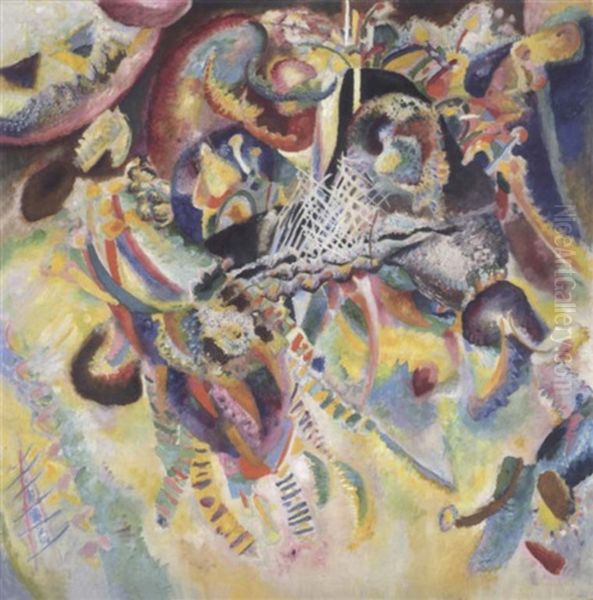
During his Bauhaus period, Kandinsky's style evolved significantly. While retaining his interest in spirituality and emotional expression, his compositions became more ordered, geometric, and architectonic. Circles, triangles, squares, and grids replaced the swirling, organic forms of his earlier abstract works. This shift reflected both the rationalist ethos of the Bauhaus and his own ongoing theoretical investigations into the fundamental elements of visual language. In 1926, he published his second major theoretical work, Punkt und Linie zu Fläche (Point and Line to Plane), a detailed analysis of the basic components of painting and their inherent expressive qualities, intended as a continuation of Concerning the Spiritual in Art.
Key works from this period, such as Composition VIII (1923) and On White II (1923), showcase this new geometric clarity combined with complex arrangements and subtle color interactions. The circle, in particular, became a dominant motif, symbolizing cosmic harmony, spiritual perfection, and the synthesis of opposing forces. Despite the emphasis on structure, his Bauhaus works retain a sense of dynamism and lyrical invention. His teaching and theoretical writings profoundly impacted Bauhaus students, including future design leaders like Herbert Bayer, shaping modern design education and aesthetics.
Parisian Finale: Biomorphic Forms and Legacy
When the Nazis forced the closure of the Bauhaus in 1933, Kandinsky, whose art was deemed "degenerate," emigrated to France. He and Nina settled in Neuilly-sur-Seine, a suburb of Paris, where he spent the last eleven years of his life. The Parisian art scene, then dominated by Cubism and Surrealism, was not entirely receptive to his particular brand of abstraction. While respected, he remained somewhat isolated from the mainstream French avant-garde, though he found kinship with artists like Joan Miró and Hans Arp, whose biomorphic forms resonated with his later work.
In his Paris period, Kandinsky synthesized elements from his earlier styles. Geometric forms softened, and playful, amoeba-like, biomorphic shapes emerged, often set against subtly modulated color fields. These late works, sometimes described as having a "microscopic" or "embryonic" quality, suggest imaginary organisms or celestial bodies floating in ethereal space. Paintings like Sky Blue (1940) and Reciprocal Accord (1942) are characterized by delicate pastel hues, intricate details, and a sense of gentle fantasy, reflecting perhaps a turn towards inner contemplation amidst the darkening political climate of Europe leading up to and during World War II. He continued to paint prolifically until shortly before his death.
Wassily Kandinsky died in Neuilly-sur-Seine on December 13, 1944, having become a French citizen in 1939. His passing marked the end of a remarkable artistic journey that had profoundly shaped the course of modern art.
Personal Life and Relationships
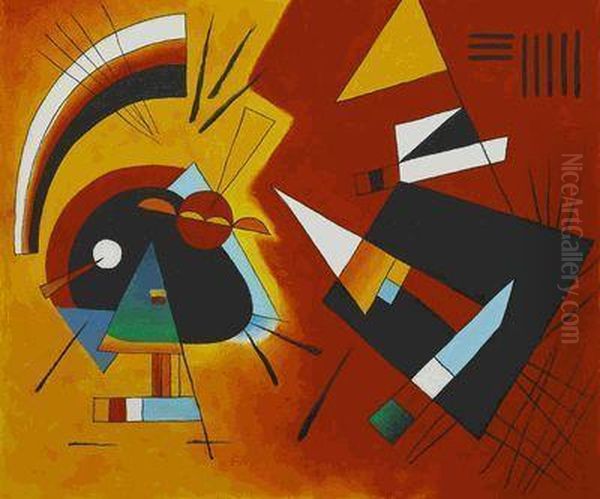
Kandinsky's personal life was marked by significant relationships that intertwined with his artistic development. His first marriage to his cousin Anna Chimiankina (1892-1911) coincided with his academic career but dissolved as he committed himself to art. His long-term partnership with Gabriele Münter (c. 1902-1914) was a period of intense artistic collaboration and personal closeness, particularly during the crucial Murnau and Blue Rider years. Their separation, precipitated by World War I, was a painful chapter. His second marriage to Nina Andreievskaia (1917-1944) provided stability during the turbulent post-revolutionary Russian years, the Bauhaus period, and their final exile in Paris. The loss of their young son Lodya was a deep personal tragedy. Throughout his life, these relationships provided both emotional support and, at times, complex dynamics that subtly influenced his path.
Enduring Influence and Stature
Wassily Kandinsky's legacy is immense and multifaceted. He is universally acknowledged as one of the principal founders of abstract art, whose radical departure from representation opened up entirely new possibilities for visual expression. His paintings, particularly those from the Blue Rider and Bauhaus periods, are considered cornerstones of modernism, celebrated for their emotional intensity, spiritual depth, and innovative use of color and form. His works are housed in major museums worldwide, including the Lenbachhaus Municipal Gallery in Munich (which holds a significant collection thanks to a donation by Gabriele Münter), the Solomon R. Guggenheim Museum in New York (which has the largest Kandinsky collection), the Centre Pompidou in Paris, and the Metropolitan Museum of Art.
His theoretical writings, especially Concerning the Spiritual in Art and Point and Line to Plane, remain essential texts for understanding modern art and aesthetics. They provided a crucial intellectual foundation for abstraction and continue to be studied by artists, historians, and critics. His ideas about the spiritual dimension of art, the synesthetic relationship between the senses, and the expressive power of pure form and color resonated throughout the 20th century and beyond. He directly influenced his contemporaries in Der Blaue Reiter and the Bauhaus, and his work was a vital precursor to later abstract movements, most notably Abstract Expressionism in the United States, impacting artists like Arshile Gorky, Jackson Pollock, and Willem de Kooning.
Controversies and Unanswered Questions
Despite his canonical status, Kandinsky's work and life are not without areas of debate and ongoing inquiry. His move to abstraction was revolutionary but met with considerable skepticism and criticism from traditionalists during his lifetime. The precise dating of his First Abstract Watercolor remains a subject of scholarly discussion. The complex symbolism in his paintings, drawing from Russian folklore, Orthodox Christianity, theosophy, and his own private cosmology, continues to invite interpretation and analysis. Some critics and psychoanalysts, like Jacques Lacan, have explored potential links between his art and psychological states, interpreting his visual language through frameworks like the "sinthome."
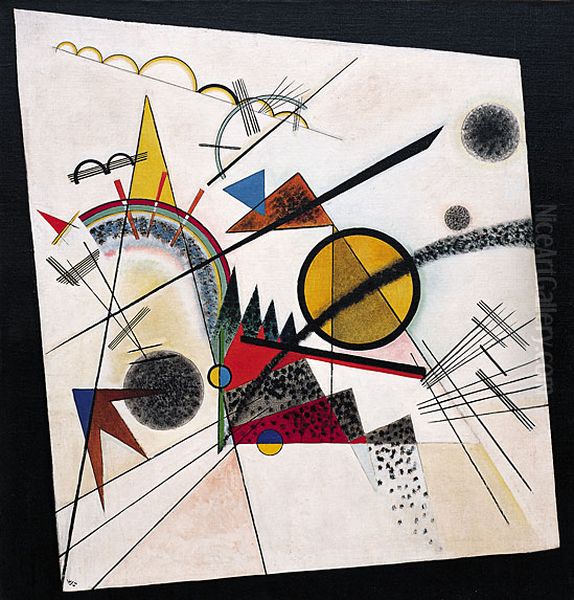
His brief engagement with the post-revolutionary Soviet regime before his departure raises questions about the relationship between avant-garde art and political ideology. Furthermore, his deep interest in spirituality and the occult, while central to his artistic vision, places his work in a context that some modernist narratives, focused purely on formal innovation, have tended to downplay. The full extent of his explorations into psychology, anthropology, and the natural sciences, hinted at in his writings and notebooks, remains an area ripe for further research. These complexities, however, only add to the richness and enduring fascination of Kandinsky's contribution to art history. He remains a pivotal figure whose quest to visualize the invisible continues to inspire and challenge viewers today.